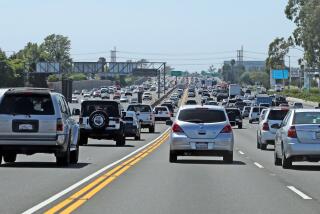Federal regulators want brake override systems in all cars
Federal regulators plan to require automakers to design a brake-throttle override system into future vehicles to reduce the risks of high-speed, unintended acceleration.
The proposal by the Department of Transportation’s National Highway Traffic Safety Administration is a result of a highly publicized 2009 crash of a Lexus ES 350 and a subsequent flood of complaints about incidents of unintended acceleration in Toyota and Lexus vehicles.
Investigators believe the Lexus crash occurred after a floor mat was improperly installed and may have trapped the accelerator pedal, causing the vehicle to race down California Highway 125 in suburban San Diego at more than 100 mph before crashing and bursting into flames, killing an off-duty California Highway Patrol officer and three members of his family.
That crash led to a recall of 3.8 million Toyota and Lexus vehicles to fix the floor mat problem and, following a Los Angeles Times series of stories on sudden unintended acceleration, subsequent recalls of millions more of the automaker’s car to fix sticking gas pedals. Lexus is a Toyota brand.
Safety officials believe brake-override systems -- in which the application of the brake pedal by the driver would instantly disengage a stuck throttle -- can prevent such crashes.
“We learned as part of the comprehensive NASA and NHTSA studies of high-speed unintended acceleration that brake override systems could help drivers avoid crashes,” said NHTSA Administrator David Strickland.
“This proposal is one way the agency is helping keep drivers safe and continuing to work to reduce the risk of injury from sticky pedals or pedal entrapment issues,” Strickland said.
The systems act as an electronic fail-safe that automatically releases the throttle when a car’s onboard computer senses that the brake pedal is depressed. Designed for cars with electronic throttle control, which use wires and software rather than mechanical cables to connect the gas pedal to the engine, it has been available for nearly a decade.
Some carmakers, including Nissan, Volkswagen, BMW and Chrysler have been using brake override for years.
“America’s drivers should feel confident that any time they get behind the wheel they can easily maintain control of their vehicles — especially in the event of an emergency,” said Transportation Secretary Ray LaHood. “By updating our safety standards, we’re helping give drivers peace of mind that their brakes will work even if the gas pedal is stuck down while the driver is trying to brake.”
However, some analysts believe such a rule won’t prevent more cases of unintended acceleration.
“This technology is typically raised as a solution to the issue of unintended acceleration. The problem is that the evidence shows this is usually a driver error issue. In other words, the gas is being applied, not the brakes,” said Jeremy Anwyl, vice chairman of auto information company Edmunds.com.
RELATED:
Auto design hinders child seat use
Hybrid buyers don’t repeat the purchase
Prices for late model used car prices continue to rise
More to Read
Inside the business of entertainment
The Wide Shot brings you news, analysis and insights on everything from streaming wars to production — and what it all means for the future.
You may occasionally receive promotional content from the Los Angeles Times.











